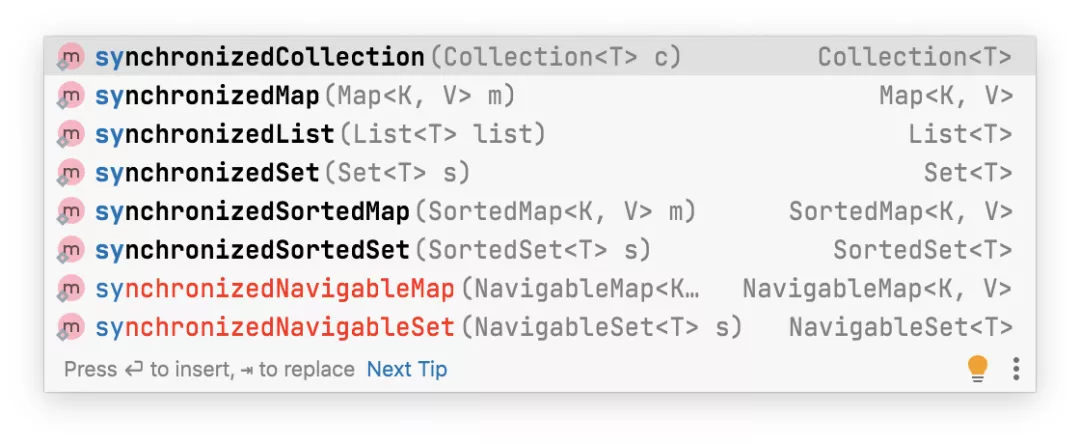Java 集合 Collections
Collections 是 JDK 提供的一个工具类,位于 java.util 包下,提供了一系列的静态方法,方便对集合进行各种骚操作,算是集合框架的一个大管家。
Collections 的用法很简单,在 Intellij IDEA 中敲完 Collections。之后就可以看到它提供的方法了,大致看一下方法名和参数就能知道这个方法是干嘛的。
这里将这些方法做了一些分类,并列举了一些简单的例子。
1、排序操作
reverse(List list):反转顺序shuffle(List list):洗牌,将顺序打乱sort(List list):自然升序sort(List list, Comparator c):按照自定义的比较器排序swap(List list, int i, int j):将 i 和 j 位置的元素交换位置
来看例子:
List<String> list = new ArrayList<>();list.add("二");list.add("三");list.add("四");list.add("五");list.add("六");System.out.println("原始顺序:" + list);// 反转Collections.reverse(list);System.out.println("反转后:" + list);// 洗牌Collections.shuffle(list);System.out.println("洗牌后:" + list);// 自然升序Collections.sort(list);System.out.println("自然升序后:" + list);// 交换Collections.swap(list, 2,4);System.out.println("交换后:" + list);
输出后:
原始顺序:[二, 三, 四, 五, 六]反转后:[六, 五, 四, 三, 二]洗牌后:[五, 二, 六, 三, 四]自然升序后:[三, 二, 五, 六, 四]交换后:[三, 二, 四, 六, 五]
2、查找操作
binarySearch(List list, Object key):二分查找法,前提是 List 已经排序过了max(Collection coll):返回最大元素max(Collection coll, Comparator comp):根据自定义比较器,返回最大元素min(Collection coll):返回最小元素min(Collection coll, Comparator comp):根据自定义比较器,返回最小元素fill(List list, Object obj):使用指定对象填充frequency(Collection c, Object o):返回指定对象出现的次数
来看例子:
System.out.println("最大元素:" + Collections.max(list));System.out.println("最小元素:" + Collections.min(list));System.out.println("出现的次数:" + Collections.frequency(list, "二"));// 没有排序直接调用二分查找,结果是不确定的System.out.println("排序前的二分查找结果:" + Collections.binarySearch(list, "二"));Collections.sort(list);// 排序后,查找结果和预期一致System.out.println("排序后的二分查找结果:" + Collections.binarySearch(list, "二"));Collections.fill(list, "八");System.out.println("填充后的结果:" + list);
输出后:
原始顺序:[二, 三, 四, 五, 六]最大元素:四最小元素:三出现的次数:1排序前的二分查找结果:0排序后的二分查找结果:1填充后的结果:[八, 八, 八, 八, 八]
3、同步控制
HashMap 是线程不安全的,其实 ArrayList 也是线程不安全的,没法在多线程环境下使用,那 Collections 工具类中提供了多个 synchronizedXxx 方法,这些方法会返回一个同步的对象,从而解决多线程中访问集合时的安全问题。
使用起来也非常的简单:
SynchronizedList synchronizedList = Collections.synchronizedList(list);
看一眼 SynchronizedList 的源码就明白了,不过是在方法里面使用 synchronized 关键字加了一层锁而已。
static class SynchronizedList<E>extends SynchronizedCollection<E>implements List<E> {private static final long serialVersionUID = -7754090372962971524L;final List<E> list;SynchronizedList(List<E> list) {super(list);this.list = list;}public E get(int index) {synchronized (mutex) {return list.get(index);}}public void add(int index, E element) {synchronized (mutex) {list.add(index, element);}}public E remove(int index) {synchronized (mutex) {return list.remove(index);}}}
那这样的话,其实效率和那些直接在方法上加 synchronized 关键字的 Vector、Hashtable 差不多(JDK 1.0 时期就有了),而这些集合类基本上已经废弃了,几乎不怎么用。
public class Vector<E>extends AbstractList<E>implements List<E>, RandomAccess, Cloneable, java.io.Serializable{public synchronized E get(int index) {if (index >= elementCount)throw new ArrayIndexOutOfBoundsException(index);return elementData(index);}public synchronized E remove(int index) {modCount++;if (index >= elementCount)throw new ArrayIndexOutOfBoundsException(index);E oldValue = elementData(index);int numMoved = elementCount - index - 1;if (numMoved > 0)System.arraycopy(elementData, index+1, elementData, index,numMoved);elementData[--elementCount] = null; // Let gc do its workreturn oldValue;}}
正确的做法是使用并发包下的 CopyOnWriteArrayList、ConcurrentHashMap。这些放到并发编程时再讲。
4、不可变集合
emptyXxx():制造一个空的不可变集合singletonXxx():制造一个只有一个元素的不可变集合unmodifiableXxx():为指定集合制作一个不可变集合
举个例子:
List emptyList = Collections.emptyList();emptyList.add("非空");System.out.println(emptyList);
这段代码在执行的时候就抛出错误了。
Exception in thread "main" java.lang.UnsupportedOperationExceptionat java.util.AbstractList.add(AbstractList.java:148)at java.util.AbstractList.add(AbstractList.java:108)at com.itwanger.s64.Demo.main(Demo.java:61)
这是因为 Collections.emptyList() 会返回一个 Collections 的内部类 EmptyList,而 EmptyList 并没有重写父类 AbstractList 的 add(int index, E element) 方法,所以执行的时候就抛出了不支持该操作的 UnsupportedOperationException 了。
这是从分析 add 方法源码得出的原因。除此之外,emptyList 方法是 final 的,返回的 EMPTY_LIST 也是 final 的,种种迹象表明 emptyList 返回的就是不可变对象,没法进行增伤改查。
public static final <T> List<T> emptyList() {return (List<T>) EMPTY_LIST;}public static final List EMPTY_LIST = new EmptyList<>();
5、其他
还有两个方法比较常用:
addAll(Collection<? super T> c, T... elements),往集合中添加元素disjoint(Collection<?> c1, Collection<?> c2),判断两个集合是否没有交集
举个例子:
List<String> allList = new ArrayList<>();Collections.addAll(allList, "九","十","二");System.out.println("addAll 后:" + allList);System.out.println("是否没有交集:" + (Collections.disjoint(list, allList) ? "是" : "否"));
输出后:
原始顺序:[二, 三, 四, 五, 六]addAll 后:[九, 十, 二]是否没有交集:否
整体上,Collections 工具类作为集合框架的大管家,提供了一些非常便利的方法。

